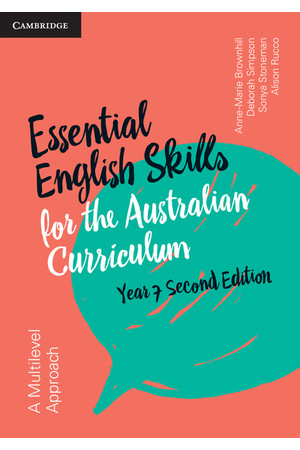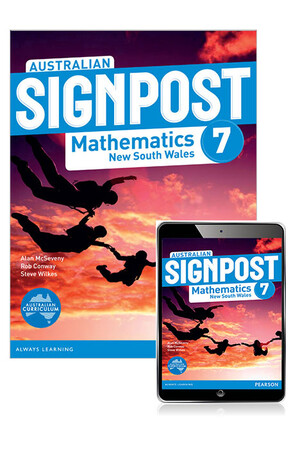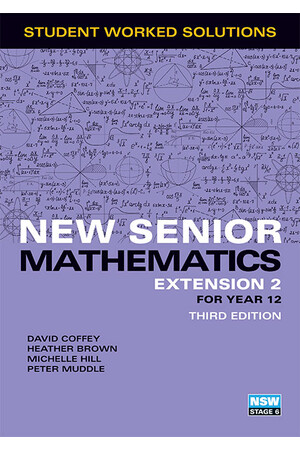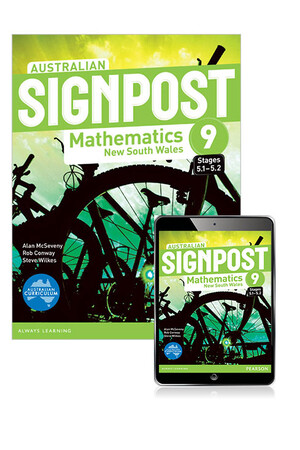Part of the series Jacaranda Core Science NSW.
View all products in this series
Jacaranda Core Science for the NSW Syllabus has been created to bring Science to life. This resource is designed to help you master scientific concepts, develop essential skills and explore real-world applications of science, all while staying perfectly aligned with the NSW Curriculum.
Data Science content, Depth Study guidance and Working Scientifically processes
Build key skills with Working Scientifically processes within the content, activities, questions and SkillBuilders. Plus dedicated Working Scientifically topics, including Depth Study guidance.
4-in-1 resource: digital, textbook, eWorkbook and eLogbook
Enjoy the flexibility of having your learning tools in multiple formats, including an eWorkbook for developing skills and an eLogbook for practical investigations.
GenAI personal tutor (jacTUTOR)
Receive personalised guidance from jacTUTOR, which helps you navigate challenging concepts and provides instant support.
Table of Contents
About this resource vi
Meet our author team xiv
Acknowledgements xvi
FOCUS AREA OBSERVING THE UNIVERSE
1 Investigating 1
1.1 Overview 2
1.2 What scientists do 4
1.3 The science laboratory 12
1.4 Making observations 22
1.5 Reporting on investigations 36
1.6 Designing investigations 44
1.7 Review 55
2 Our place in space 61
2.1 Overview 62
2.2 Our solar system 63
2.3 Our local star 73
2.4 Earth in motion 77
2.5 The Moon in motion 83
2.6 Lunar and solar eclipses 90
2.7 Cultural Knowledges of astronomy 95
2.8 Eyes on the skies 99
2.9 Review 106
FOCUS AREA FORCES
3 Forces in action 113
3.1 Overview 114
3.2 Direct and indirect forces 116
3.3 Friction forces in everyday life 124
3.4 Analysing forces 131
3.5 Gravitational forces and weight 138
3.6 Forces and objects in orbit 148
3.7 Electrostatic forces 153
3.8 Magnetic forces 161
3.9 Electromagnets 170
3.10 Review 179
4 Forces in context 185
4.1 Overview 186
4.2 Simple machines 187
4.3 Inclined forces 199
4.4 Gearing up 209
4.5 Review 220
FOCUS AREA CELLS AND CLASSIFICATION
5 Cells 225
5.1 Overview 226
5.2 The cell theory 228
5.3 Light microscopes 234
5.4 Cell structure 246
5.5 Single-celled organisms 257
5.6 Specialised cells in multicellular organisms 264
5.7 The arrangement of specialised cells 270
5.8 Microscopic images 286
5.9 Review 296
6 Classification 301
6.1 Overview 302
6.2 Classification 304
6.3 The binomial system of nomenclature 310
6.4 Dichotomous keys 319
6.5 Classifying animals 325
6.6 Classifying vertebrates 334
6.7 Classifying invertebrates 345
6.8 Classifying plants 352
6.9 Changing classifications 362
6.10 Surviving in the Australian environment 366
6.11 Classification in Aboriginal and Torres Strait Islander Cultures 375
6.12 Review 382
FOCUS AREA SOLUTIONS AND MIXTURES
7 Properties of matter 389
7.1 Overview 390
7.2 States of matter 391
7.3 The particle model 396
7.4 Changing states 404
7.5 Density 411
7.6 Buoyancy 421
7.7 Review 425
8 Mixed up liquids 429
8.1 Overview 430
8.2 Pure substances and mixtures 432
8.3 Solutions 437
8.4 Concentration 444
8.5 Mixing insoluble substances 450
8.6 Separation techniques 454
8.7 Separating solutions 463
8.8 Water purification techniques 473
8.9 Review 477
FOCUS AREA LIVING SYSTEMS
9 Living systems 481
9.1 Overview 482
9.2 Cells getting organised 484
9.3 The digestive system 487
9.4 Taking in nutrients 493
9.5 The respiratory system 500
9.6 The circulatory system 505
9.7 The heart 510
9.8 The excretory system 516
9.9 System breakdown 521
9.10 Plant parts 524
9.11 Zooming in on leaves 530
9.12 Review 535
10 Ecosystems 539
10.1 Overview 540
10.2 A place to call home 541
10.3 Field work 547
10.4 Ecosystems are solar powered 554
10.5 Food chains and food webs 559
10.6 Ecological pyramids 566
10.7 Cycling matter 570
10.8 Changes in population 574
10.9 At risk of extinction 580
10.10 Review 589
FOCUS AREA PERIODIC TABLE AND ATOMIC STRUCTURE
11 Types of matter 593
11.1 Overview 594
11.2 Revisiting the particle theory 596
11.3 Meet the elements 601
11.4 Is it a metal? 606
11.5 Properties and uses 609
11.6 Atomic structure 612
11.7 Early models of the atom 616
11.8 More recent models of the atom 621
11.9 Review 627
12 The periodic table 631
12.1 Overview 632
12.2 Introducing the periodic table 633
12.3 Chemical formulas 638
12.4 Chemical tests 644
12.5 Representing atoms 652
12.6 Developing the periodic table 655
12.7 Periodic table trends 660
12.8 Review 668
FOCUS AREA CHANGE
13 Energy transfers 671
13.1 Overview 672
13.2 Energy transfers and transformations 673
13.3 Heat and temperature 679
13.4 Using electrical energy 692
13.5 Open and closed systems 709
13.6 Review 714
14 Chemical change 717
14.1 Overview 718
14.2 Time for a change? 720
14.3 Faster and slower 733
14.4 Rusting is a chemical reaction 738
14.5 Acids and bases 746
14.6 Acid rain 752
14.7 Review 757
15 Geological change 761
15.1 Overview 762
15.2 Tectonic plates 764
15.3 Cultural accounts of earthquakes and volcanoes 767
15.4 Solid rock 771
15.5 Fiery rocks 777
15.6 Wearing away 782
15.7 Sedimentary rocks 788
15.8 Time trapped in rocks 791
15.9 Rocky changes 797
15.10 Review 804
FOCUS AREA DATA SCIENCE 1
16 Data science 809
16.1 Overview 810
16.2 Understanding data 812
16.3 Scientific models 819
16.4 Interpreting data 829
16.5 Storing and handling data 838
16.6 Review 847
FOCUS AREA WORKING SCIENTIFICALLY
17 Working scientifically and depth study guidance 849
17.1 Overview 850
17.2 Observing 852
17.3 SkillBuilder - Reading a scale 857
17.4 Questioning and predicting 860
17.5 SkillBuilder - Writing an aim and forming a hypothesis 864
17.6 Planning investigations 866
17.7 SkillBuilder - Control of variables 871
17.8 Conducting investigations 873
17.9 Organising data 878
17.10 SkillBuilder - Creating a simple column or bar graph 889
17.11 SkillBuilder - Drawing scatter plots and line graphs 892
17.12 SkillBuilder - Constructing a pie chart 895
17.13 SkillBuilder - Using a spreadsheet 898
17.14 Problem solving 903
17.15 Depth study guidance 907
17.16 Review 911
Periodic table
Glossary915
Index 931
| ISBN | 9781394317981 |
| Publisher | Jacaranda |
| Product Type | Student Books, |
| Year Level | Year 7, Year 8, |
Be The First To Review This Product!
Help other Teacher Superstore users shop smarter by writing reviews for products you have purchased.























